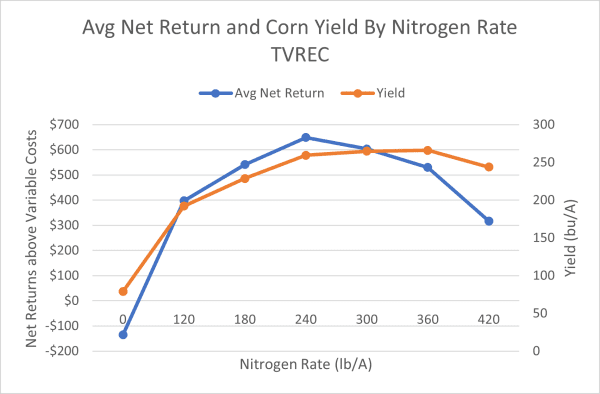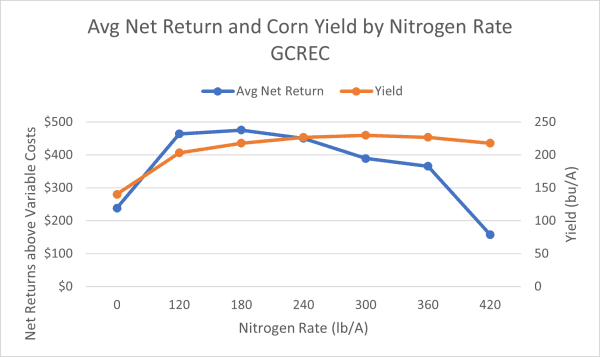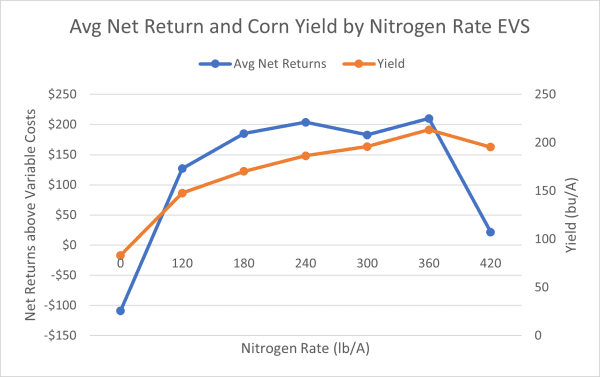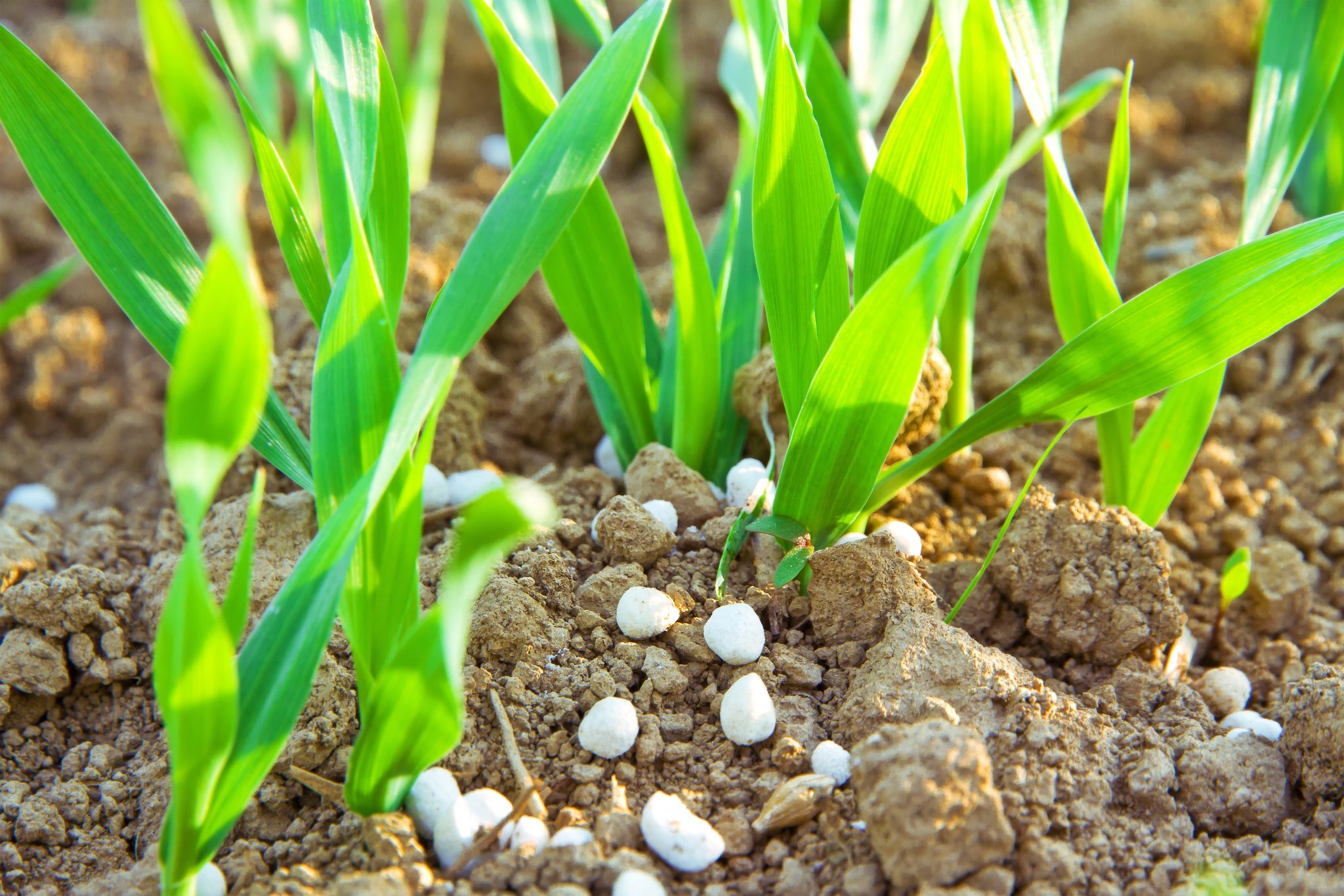Crop Production

Profit maximization should be one of the fundamental goals of any business operation. However, that is not always easy for farmers and maximizing yield often becomes the decision of choice. During times of low commodity prices this necessitates determining what inputs could be reduced while still achieving high yielding production. While crop prices can increase, so too can input costs. In particular, fertilizer can greatly help yield production but when fertilizer prices increase it can have a major impact on the management decisions necessary to maintain profitability.
During a time of rising fertilizer prices, growers are having to revisit their fertilizer strategies for crops like corn and cotton. Previous research on corn by Audrey Gamble with Auburn University has provided a distinct yield response curve to variable nitrogen (N) rates under different soil types in Alabama. Notably, higher N rates do not always equate to higher yield potential. Even more important to note is that N rates to achieve maximum yield are not always going to result in the highest net return.
Research-Based Evidence of Maximizing Yield vs Maximizing Net Returns
We use corn yields from nitrogen trials in Alabama during 2019-2021 to illustrate how different nitrogen rates affect yield and net returns. The tables assume a fertilizer price for N (34-0-0) is $900/ton. Other variable costs are based on the 2022 Alabama Extension irrigated corn budget. Note that net returns are calculated without land rent and represent a return to fixed costs, including opportunity cost of management, land, depreciation, and general overhead.
In a Decatur silt loam soil type the highest yield occurs with a nitrogen rate of 360 pounds/acre (Figure 1). However, the net returns above all variable costs were greatest when applying 240 pounds N/acre. Similarly, for a Dothan sandy loam location (Figure 2), the highest net returns were realized with a 180 pounds/acre fertilizer rates, compared to a 300 pounds N/acre that would maximize yield. At a central Alabama location with Marvyn sandy loam soil (Figure 3), the highest yield and returns were both 360 pounds/acre of N.

Figure 1. Average net returns assuming fertilizer price for N (34-0-0) at $900/ton on a Decatur silt loam soil at the Tennessee Valley Research Center (TVREC), Madison, Alabama.

Figure 2. Average net returns assuming fertilizer price for N (34-0-0) at $900/ton on a Dothan sandy loam soil at the Gulf Coast Research Center (GCREC), Fairhope, Alabama.

Figure 3. Average net returns for irrigated corn assume fertilizer price for N (34-0-0) at $900/ton on a Marvyn sandy loam soil at the EV Smith Research Center (EVS), Shorter, Alabama.
Maximizing Net Returns is Dependent on Fertilizer Prices and Soil Type
Managing to maximize net returns, however, isn’t static and the ideal input rates for nitrogen or any other nutrient will be highly variable depending on the current fertilizer price and soil type. When fertilizer prices are lower, it may be more profitable to use a higher rate of N in corn production such as is seen at GCREC (Table 1). Even in locations where both yield and net returns are greatest with a higher rate of N, like EVS in this trial, further increases in fertilizer prices could result in lost profit if nitrogen applications are made only to maximize yield.
Table 1. Nitrogen Rates Necessary to Maximize Net Returns in Corn at Different Fertilizer Prices
Location $500/T $800/T $900/T $1000/T
EVS (Marvyn sandy Loam) 360 lb/acre 360 lb/acre 360 lb/acre 240 lb/acre
GREC (Dothan sandy loam) 240 lb/acre 180 lb/acre 180 lb/acre 180 lb/acre
TVREC (Decatur silt loam) 240 lb/acre 240 lb/acre 240 lb/acre 240 lb/acre
Points to Consider
It is crucial to plan for input management before planting. The first steps are soil sampling, budgeting, and knowing the yield potential for each field. Baseline field nutrient availability should be established every year to determine adequate application needs. Soil sample recommendations from Alabama Cooperative Extension are developed through years of continued research to ensure recommendations are accurate for currently available crop varieties. Budgets should be developed and updated each year for an individual operation to accurately determine input costs, expected returns, and where input savings can be found. Updated Extension budgets for row crops can assist growers in determining costs and returns. Using reasonable yield goals to develop budgets and determine input needs is also critical in the planning process. Nitrogen budgets can also help develop an understanding of nitrogen cycling and evaluation of nitrogen management.
The key point to remember is that managing for the highest yield and managing for the highest net return aren’t always the same management practices. It is important to implement a management strategy that will maximize net returns and ultimately maximize profit in the crop production.

